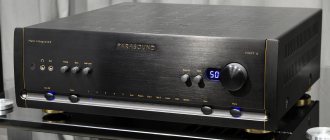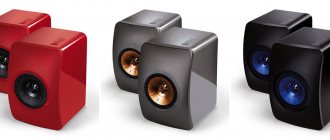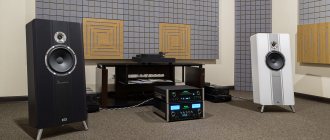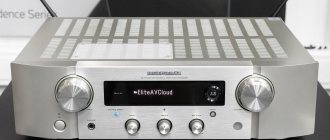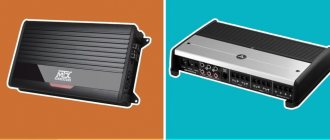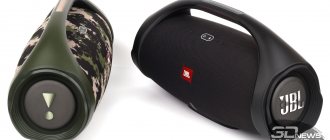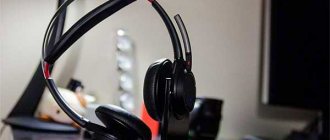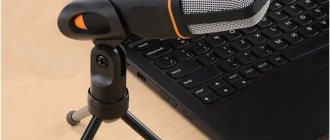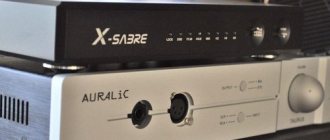Stereo receivers are not the most common devices on the market today. Even the name itself has a slight “vintage” flavor. However, the Emotiva TA-100 is an absolutely modern device, and at the same time a “bridge” connecting the past and the present. Let's see what he's really like.
The segment in which the Emotiva TA-100 can be placed is quite budget-friendly, but the first impression of the receiver is pleasant. Everything is done well and carefully, consumer goods are not visible, even adjusted for the segment and price. And you would never guess, looking from the outside, that this is a stereo receiver.
Making amplifiers according to the “all-in-one” principle was previously common among many manufacturers, but today the composition of the components has changed. In relation to the Emotiva TA-100, the part of the receiver that is represented by the tuner can be immediately left aside - everything is clear with it. By the way, looking ahead, I will say that the tuner catches quite well.
Externally, the Emotiva TA-100 looks quite good, the device is “drawn” in an interesting way
Otherwise, by its nature, this device (except for the tuner and “receiver”) is a classic integrated amplifier in class AB, to which analog and digital components are added.
Moderation and Honesty
The analog part is represented by several linear unbalanced inputs, the already mentioned tuner, and a phono preamplifier, which can work with both MM and MC heads, but without the possibility of tuning, designed for either 47 kOhm or 100 Ohm. In addition, there is a preamplifier output and an output for connecting a subwoofer, as well as a headphone output.
By the way, there is a nice function hidden here - the device remembers the set volume for acoustics and headphones. And if you simply unplug the headphone cord, the acoustics will work at the volume that was previously set for it.
The digital part is represented by a built-in DAC with a decent set of inputs. And there are a couple of interesting points here. The DAC itself is built on an Analog Devices AD1955 chip, which is not very common these days. In its own way, this is such an “old school” solution.
The functionality of the DAC turned out to be not as advanced as is now accepted. For digital inputs, the received signal is limited to 24 bit/192 kHz, and for USB - 24 bit/96 kHz. However, this is not very critical if we talk specifically about potential sound.
The body and finishing elements are quite high quality
The second feature of the DAC and the device as a whole is that the now so fashionable Bluetooth aptX is not present in the basic implementation, and everything else networked and wireless is not available at all. But if necessary, there is a connector on the rear panel for a “native” aptX USB receiver, which can add wireless functionality.
I’ll also tell you about the receiver in advance - it works stably, does not fall off or lag, plays as it should, and transmits the names of connected devices to the receiver. I won’t look at it in detail, just like the tuner - it’s just important for us that this functionality is present and it’s functional.
For control there is a trigger connector and a simple remote control. Although it is in the mode of use, and not settings, that you can do without a remote control. There are a minimum of buttons on the panel, but more are not needed. The device is also worth praising for its proprietary backlight. In operating mode, the blue color is extremely non-irritating and not bright, and in standby mode, only the power button, located in the center, glows with a soft yellowish light - which again does not interfere at all.
The power button illuminates yellow in standby mode
If you examine the device from the inside, the picture will be as follows: a classic linear power supply with a toroidal transformer, which accounts for almost the majority of the weight, an amplifier part with a radiator hidden inside the case and a familiar arrangement of a pair of transistors per channel. The DAC, preamplifier and phono stage are assembled on a separate single board. In general, everything turns out neatly and efficiently.
Assembly and installation are very good. The stated specifications of the amplifier may be more modest than we would like, but they raise far fewer questions than if the numbers were inflated. However, the power parameters are quite normal in class, both for modern amplifiers and for devices from the past. And they are quite enough for average, not very tight acoustics.
Rear panel of Emotiva TA-100. From it you can immediately understand the functionality, and it looks balanced. There’s a lot of everything, but there’s nothing superfluous or illogical, just like there’s nothing frankly missing
Based on the combination of design and functionality, I had a pleasant impression. In fact, there is a lot of everything, but in moderation - there is no excess. That is, I did not find a single function that seemed redundant. Well, except that the MC phono stage looks a little strange. However, they also produce inexpensive MC heads.
And everything else is appropriate and quite good. Even the DAC, which at first glance seems a little simplified in terms of bit depth and frequency numbers, in fact does not cause rejection. Many studio devices still in use operate at 24 bit/96 kHz or 24 bit/192 kHz - and nothing. Here, it’s more likely that DSD support coupled with something else like HDMI, sold at residual value, would look like just numbers on the passport or an extra connector added at the expense of quality.
This is what Emotiva BTM-1 looks like - an optional Bluetooth aptX module
So it’s logical that the manufacturer did as much as possible conscientiously, and did not try to stuff the device with everything according to the “just have it” principle. However, for now we can only talk about quality based on external features and design - it’s time to listen.
Emotiva TA-100 stereo receiver test: fun sound on a low budget
Stereo receivers are not the most common devices on the market today. Even the name itself has a slight “vintage” flavor. However, the Emotiva TA-100 is an absolutely modern device, and at the same time a “bridge” connecting the past and the present. Let's see what he's really like.
The segment in which the Emotiva TA-100 can be placed is quite budget-friendly, but the first impression of the receiver is pleasant. Everything is done well and carefully, consumer goods are not visible, even adjusted for the segment and price. And you would never guess, looking from the outside, that this is a stereo receiver.
Making amplifiers according to the “all-in-one” principle was previously common among many manufacturers, but today the composition of the components has changed. In relation to the Emotiva TA-100, the part of the receiver that is represented by the tuner can be immediately left aside - everything is clear with it. By the way, looking ahead, I will say that the tuner catches quite well.
Externally, the Emotiva TA-100 looks quite good, the device is “drawn” in an interesting way
Otherwise, by its nature, this device (except for the tuner and “receiver”) is a classic integrated amplifier in class AB, to which analog and digital components are added.
Moderation and Honesty
The analog part is represented by several linear unbalanced inputs, the already mentioned tuner, and a phono preamplifier, which can work with both MM and MC heads, but without the possibility of tuning, designed for either 47 kOhm or 100 Ohm. In addition, there is a preamplifier output and an output for connecting a subwoofer, as well as a headphone output.
By the way, there is a nice function hidden here - the device remembers the set volume for acoustics and headphones. And if you simply unplug the headphone cord, the acoustics will work at the volume that was previously set for it.
The digital part is represented by a built-in DAC with a decent set of inputs. And there are a couple of interesting points here. The DAC itself is built on an Analog Devices AD1955 chip, which is not very common these days. In its own way, this is such an “old school” solution.
The functionality of the DAC turned out to be not as advanced as is now accepted. For digital inputs, the received signal is limited to 24 bit/192 kHz, and for USB - 24 bit/96 kHz. However, this is not very critical if we talk specifically about potential sound.
The body and finishing elements are quite high quality
The second feature of the DAC and the device as a whole is that the now so fashionable Bluetooth aptX is not present in the basic implementation, and everything else networked and wireless is not available at all. But if necessary, there is a connector on the rear panel for a “native” aptX USB receiver, which can add wireless functionality.
I’ll also tell you about the receiver in advance - it works stably, does not fall off or lag, plays as it should, and transmits the names of connected devices to the receiver. I won’t look at it in detail, just like the tuner - it’s just important for us that this functionality is present and it’s functional.
For control there is a trigger connector and a simple remote control. Although it is in the mode of use, and not settings, that you can do without a remote control. There are a minimum of buttons on the panel, but more are not needed. The device is also worth praising for its proprietary backlight. In operating mode, the blue color is extremely non-irritating and not bright, and in standby mode, only the power button, located in the center, glows with a soft yellowish light - which again does not interfere at all.
The power button illuminates yellow in standby mode
If you examine the device from the inside, the picture will be as follows: a classic linear power supply with a toroidal transformer, which accounts for almost the majority of the weight, an amplifier part with a radiator hidden inside the case and a familiar arrangement of a pair of transistors per channel. The DAC, preamplifier and phono stage are assembled on a separate single board. In general, everything turns out neatly and efficiently.
Assembly and installation are very good. The stated specifications of the amplifier may be more modest than we would like, but they raise far fewer questions than if the numbers were inflated. However, the power parameters are quite normal in class, both for modern amplifiers and for devices from the past. And they are quite enough for average, not very tight acoustics.
Rear panel of Emotiva TA-100. From it you can immediately understand the functionality, and it looks balanced. There’s a lot of everything, but there’s nothing superfluous or illogical, just like there’s nothing frankly missing
Based on the combination of design and functionality, I had a pleasant impression. In fact, there is a lot of everything, but in moderation - there is no excess. That is, I did not find a single function that seemed redundant. Well, except that the MC phono stage looks a little strange. However, they also produce inexpensive MC heads.
And everything else is appropriate and quite good. Even the DAC, which at first glance seems a little simplified in terms of bit depth and frequency numbers, in fact does not cause rejection. Many studio devices still in use operate at 24 bit/96 kHz or 24 bit/192 kHz - and nothing. Here, it’s more likely that DSD support coupled with something else like HDMI, sold at residual value, would look like just numbers on the passport or an extra connector added at the expense of quality.
This is what Emotiva BTM-1 looks like - an optional Bluetooth aptX module
So it’s logical that the manufacturer did as much as possible conscientiously, and did not try to stuff the device with everything according to the “just have it” principle. However, for now we can only talk about quality based on external features and design - it’s time to listen.
On the side of emotions
I listened first by connecting my traveling Macbook Air via USB. I did not turn off the software in the form of Audirvana so that the digital source remained familiar. Then I listened to it with some other source connected via line input, and finally left the phono stage, tuner and Bluetooth. However, I have already mentioned them - Bluetooth works, the tuner can pick up, and the phono stage is quite suitable for a turntable of the same class with a MM head.
Using the Psapp album “The Only Thing I Ever Wanted” as an example, the sound seemed to me light, leisurely, but not lazy. With good volume and enough air. There is a slight emphasis on the vocal range, but nothing more. Detail is confidently average, without digging in, but also without noticeable simplification.
In some places there is a feeling of slightly veiled after-sounds, but this can clearly only be noticed in direct comparison with a higher-class system. Otherwise, even if there is a hint of warmth or color, it is difficult to distinguish it clearly. Although already at this stage you can guess that significantly complex acoustics are contraindicated for the amplifier. However, I didn’t expect anything else.
Inside the Emotiva TA-100 everything is done neatly
The stage is larger than average, wide, even with good depth and a sense of air. The images are quite proportionate, there is fullness and mobility, but without holographic precision. In general, it can be suitable even for attentive listening, and for background sound - without any questions at all.
Next I played the album “Alone Together” by Masaru Imada and George Mraz. On this material, the presentation seemed more rounded and warm to me. But what I liked was the recording, which was somewhat problematic in terms of bass; the receiver worked well, without increasing the features to the point of being a problem. And the scene here also turned out to be large, but, as far as possible, correct.
Another feature immediately appeared more clearly. In the balance between information and emotion, the device clearly takes the emotional side. But at the same time, without a strong drawdown in detail and without loud intrusiveness. It’s just that the sound is assembled from components in a fairly proportional manner, and does not go out of order. If you wish, you can easily follow each instrumental part, but you just don’t want to do this.
On the one hand, this is a focus on a specific listener, but listeners are different, all with their own preferences. And what’s interesting here is that I hear that the detail is somewhere at an average level. Not a mess, but I'm used to more nuances. At the same time, I notice that the music is transmitted in a recognizable way - the way I know it using completely different systems.
That is, according to these parameters, the receiver does not recolor or alter the sound. On the contrary, precisely in terms of the reliability of the emotional and musical presentation, in terms of conveying the mood and spectrum of emotions, this device is better than what could initially be expected.
Another album is Peter Green Splinter Group's "Destiny Road". There is both good volume and elasticity of sound. The upper frequencies are not bright and not sharp, the vocal range is a little accentuated, and the middle seems a little raised here. Rhythmic and emotional sound, slightly light, not heavy. There is air, and the stage, as far as this recording allows, is built correctly. The scale is slightly larger than average, the volume is airy, not oppressive.
Predictable character
To test how the receiver would behave on more complex material, I played Schnittke’s Symphony No. 1. Oddly enough, even the bass work turned out to be quite good. The volume of the hall and the air are also better than expected. Timbrally, the sound is the same as before - a little light and maybe even a little warm, dynamics are present, detail is the same confidently average. But emotions are surprisingly well read; even subtle transitions do not need to be guessed or thought out.
And the last disc is Cecilia Bartoli “Maria”. Here, on complex fragments, the attack turned out to be slightly smoothed out, and the details were not super accurate. The highs, however, seemed to be worked out more confidently, and both the middle and vocal parts are at least slightly accentuated, but are not perceived as synthetic. But the musicality, on the contrary, surprised me. The sound is not perceived as boring, sleepy or plasticine. Not at all - there are emotions, and the volume of the stage, and the airiness of the space.
Then I listened to part of the same sample not through the built-in DAC, but through an external digital source. I didn’t have a device corresponding to the level of the Emotiva TA-100, so I had to use a source several times higher in price and class than the entire receiver.
What’s interesting is that there were no fundamental changes in the sound. More precisely, I, of course, heard a difference in the sources, but the same mid-frequency presentation, the same somewhat averaged detail remained. And the volume is approximately the same.
There were more noticeable changes in dynamics, and in terms of development of the highs, the sound came out sharper and more accurate, while the other components of the signature did not change much. Some time after the test, I tried another digital source, with a different character, but the result was the same.
We can conclude that the main tone here is set by the amplifier, and it has a system-forming character to which all other add-ons in the Emotiva TA-100 design are adjusted. However, such predictability is not bad in itself.
conclusions
Quite balanced, in my opinion, functionality. The device has everything that is really needed, and there is nothing superfluous. And the receiver is nicely made. That is, according to formal criteria, the device simply must feel confident in its budget niche.
The sound of the device has some peculiarities, but they look quite solid, not like some kind of absurdity. Although here a lot will depend on the acoustics. I would be looking for something moderately bright in sound, fast and easy to build up. Something with not the lowest sensitivity and light paper diffusers, if you try to get creative.
However, it could almost be an acoustic system with a horn top, as long as it is not slow in terms of amplification and not slow-witted in itself. But with something easy in all respects, from physics to character, this receiver can open up well.
Another interesting thing about the device is that it doesn’t play boringly, coldly or distantly. There may be a little coloration, but there is no simplistic dull sound, which is often found in the budget segment.
Official website: Emotiva TA-100, Emotiva BTM-1
Musical material
A. Schnittke - Symphony No. 1 - Gennady Rozhdestvensky, State Symphony Orchestra of the USSR Ministry of Culture / Recording SUSD 10-00062 / Stereo
Cecilia Bartoli - Maria / Decca 475 9077 / Stereo
Masaru Imada and George Mraz - Alone Together / Three Blind Mice TBM XR 5003
Peter Green Splinter Group — Destiny Road / Artisan Recordings – 128172 / Stereo
Psapp — The Only Thing I Ever Wanted / Domino DNO 095 / CD Stereo
Passport details
Analog inputs: 2 linear unbalanced, phono MM/MC
Digital inputs: S/PDIF 24/192 kHz, Toslink 24/192 kHz, USB 24/96 kHz, Bluetooth aptX with optional receiver
Outputs: preamplifier, headphone output, mono subwoofer output
Output Power: 50 W into 8 ohms per channel 20 Hz - 20 kHz; THD <0.02%; 90 W per channel (1 kHz; THD <1%; into 4 ohms)
Frequency range: 20 Hz – 20 kHz; +0 dB/-0.25 dB (at 8 ohms), 20 Hz – 80 kHz; +0/-3 dB
THD+noise: <0.05% (A scale)
Signal-to-noise ratio: >100 dB (A-weighted; full rated power)
Signal-to-noise ratio: >85 dB (A-weighted; rated power 1 W)
Phono stage:
Frequency range: (MM and MC): 20 Hz – 20 kHz; according to RIAA standard curve
THD+noise: <0.015% (MM; A scale); <0.06% (MC; A scale)
Signal-to-noise ratio: > 90dB (MM); >68 dB (MC)
Built-in DAC:
Frequency response: 5 Hz - 20 kHz, ±0.15 dB (44 kHz); 5 Hz – 80 kHz, ±0.25 dB (192 kHz)
THD+noise: <0.003% (A-weighted; all sample rates)
Intermodulation distortion: <0.007% (SMPTE standards)
Signal-to-noise ratio: >110 dB
Headphone output:
Output power (ohms/mW per channel): 8/23, 33/90, 47/127, 150/145, 300/114, 600/75
Power: 115 or 230 V, 50/60 Hz
Dimensions (WxDxH): 432x67x318 mm (excluding connectors)
Weight: 6.8 kg
Source: stereo.ru
Go to the manufacturer's catalog
On the side of emotions
I listened first by connecting my traveling Macbook Air via USB. I did not turn off the software in the form of Audirvana so that the digital source remained familiar. Then I listened to it with some other source connected via line input, and finally left the phono stage, tuner and Bluetooth. However, I have already mentioned them - Bluetooth works, the tuner can pick up, and the phono stage is quite suitable for a turntable of the same class with a MM head.
Using the Psapp album “The Only Thing I Ever Wanted” as an example, the sound seemed to me light, leisurely, but not lazy. With good volume and enough air. There is a slight emphasis on the vocal range, but nothing more. Detail is confidently average, without digging in, but also without noticeable simplification.
In some places there is a feeling of slightly veiled after-sounds, but this can clearly only be noticed in direct comparison with a higher-class system. Otherwise, even if there is a hint of warmth or color, it is difficult to distinguish it clearly. Although already at this stage you can guess that significantly complex acoustics are contraindicated for the amplifier. However, I didn’t expect anything else.
Inside the Emotiva TA-100 everything is done neatly
The stage is larger than average, wide, even with good depth and a sense of air. The images are quite proportionate, there is fullness and mobility, but without holographic precision. In general, it can be suitable even for attentive listening, and for background sound - without any questions at all.
Next I played the album “Alone Together” by Masaru Imada and George Mraz. On this material, the presentation seemed more rounded and warm to me. But what I liked was the recording, which was somewhat problematic in terms of bass; the receiver worked well, without increasing the features to the point of being a problem. And the scene here also turned out to be large, but, as far as possible, correct.
Another feature immediately appeared more clearly. In the balance between information and emotion, the device clearly takes the emotional side. But at the same time, without a strong drawdown in detail and without loud intrusiveness. It’s just that the sound is assembled from components in a fairly proportional manner, and does not go out of order. If you wish, you can easily follow each instrumental part, but you just don’t want to do this.
On the one hand, this is a focus on a specific listener, but listeners are different, all with their own preferences. And what’s interesting here is that I hear that the detail is somewhere at an average level. Not a mess, but I'm used to more nuances. At the same time, I notice that the music is transmitted in a recognizable way - the way I know it using completely different systems.
That is, according to these parameters, the receiver does not recolor or alter the sound. On the contrary, precisely in terms of the reliability of the emotional and musical presentation, in terms of conveying the mood and spectrum of emotions, this device is better than what could initially be expected.
Another album is Peter Green Splinter Group's "Destiny Road". There is both good volume and elasticity of sound. The upper frequencies are not bright and not sharp, the vocal range is a little accentuated, and the middle seems a little raised here. Rhythmic and emotional sound, slightly light, not heavy. There is air, and the stage, as far as this recording allows, is built correctly. The scale is slightly larger than average, the volume is airy, not oppressive.
Predictable character
To test how the receiver would behave on more complex material, I played Schnittke’s Symphony No. 1. Oddly enough, even the bass work turned out to be quite good. The volume of the hall and the air are also better than expected. Timbrally, the sound is the same as before - a little light and maybe even a little warm, dynamics are present, detail is the same confidently average. But emotions are surprisingly well read; even subtle transitions do not need to be guessed or thought out.
And the last disc is Cecilia Bartoli “Maria”. Here, on complex fragments, the attack turned out to be slightly smoothed out, and the details were not super accurate. The highs, however, seemed to be worked out more confidently, and both the middle and vocal parts are at least slightly accentuated, but are not perceived as synthetic. But the musicality, on the contrary, surprised me. The sound is not perceived as boring, sleepy or plasticine. Not at all - there are emotions, and the volume of the stage, and the airiness of the space.
Then I listened to part of the same sample not through the built-in DAC, but through an external digital source. I didn’t have a device corresponding to the level of the Emotiva TA-100, so I had to use a source several times higher in price and class than the entire receiver.
What’s interesting is that there were no fundamental changes in the sound. More precisely, I, of course, heard a difference in the sources, but the same mid-frequency presentation, the same somewhat averaged detail remained. And the volume is approximately the same.
There were more noticeable changes in dynamics, and in terms of development of the highs, the sound came out sharper and more accurate, while the other components of the signature did not change much. Some time after the test, I tried another digital source, with a different character, but the result was the same.
We can conclude that the main tone here is set by the amplifier, and it has a system-forming character to which all other add-ons in the Emotiva TA-100 design are adjusted. However, such predictability is not bad in itself.
Stereo amplifier Emotiva A-300
Reviews
—hifivoyage
Pros: High-level sound and pleasant timbre of presentation! High detail, natural stage construction, Power at this price is 300 watts 4 ohm!
Cons: For the price there are no cons!
Comment: The high power output of the a300 speaks for itself. In normal home use it does not get hot. The sound of the amplifier is slightly warm in presentation, which affects the exceptionally pleasant timbre of the sound. PS.A300 is a power amplifier (it is transparent to the signal) and 90 percent of the quality depends on the preamplifier source from which sound is supplied to the A300. What quality you give is what you get!!! p.s. it’s no wonder that competitors are losing in all respects and are trying in every possible way to make up tall tales about the a300!!!
— Alexander K.
Pros: ... after purchasing the pt-100, everything fell into place, noise and interference from the channels went away, complete silence. The sound after the Yamaha as 501 is more pleasant, soft, detailed, the stage guys, the stage is just awesome. The highs are very natural, pleasant, juicy, you can listen to soft rock for hours, for example. Bass...bass guys is a different story: elastic, powerful, meaty, fast, the blow, so to speak, has become vacuum and, most importantly, less booming like Yamaha. I began to notice that I was listening to the vocals, the mids were of course very natural, warm, there was no dryness in the upper mids. Any GUITAR sounds just super, I began to hear how the bass guitar and bass player work on fast Metallica parts. The result is that I am very pleased with the purchase of this bundle, thanks to Emotiva.
Cons: ... fans, they can’t be called anything else.
Comment: I listen to CDs (for now) through a Sony blue-ray player on a pre-DAC, AudioQuest interconnects, Cerwin Vega acoustics! The digital data is still via a phone number (I’m planning on using a laptop), I’m not familiar with hi-res formats yet.
—hifivoyage
Pros: High-level sound and pleasant timbre of presentation! High detail, natural stage construction, Incomparable power at this price 300 watts 4 ohm!
Cons: There are no downsides to the price for this quality of sound and workmanship!
Comment: The high power output of the a300 speaks for itself. For an amount 2 and 3 times greater, you rarely find an amplifier with such a doubling of Power at 4 ohms 300 watts and at 8 ohms 150 watts. Moreover, it was measured using instruments and confirmed repeatedly in various sources! The A300 beats out its competitors for both 100 and 150 thousand rubles. As an example, I compared it with the Parasound Halo A23 (used it for about a year) for 150,000 rubles, price on 02.15.21 and A300 price 50 tr. localization of images and in terms of linearity of frequency response and high detail the a23 did not leave a chance. In normal home use it does not heat up. The sound of the amplifier is transparent and slightly warm in presentation, which affects the exceptionally pleasant timbre of the sound. This is the highest class. You will hear the sound! PS.A300 is a power amplifier (it is transparent to the signal) and 90 percent of the quality depends on the preamplifier source from which sound is supplied to the A300. What quality you give is what you get!!! p.s. it’s no wonder that competitors are losing in all respects and are trying in every possible way to make up tall tales about the a300!!!
Show all reviews about Stereo amplifier Emotiva A-300
Reviews Stereo amplifier Emotiva A-300 Show all reviews Stereo amplifier Emotiva A-300
conclusions
Quite balanced, in my opinion, functionality. The device has everything that is really needed, and there is nothing superfluous. And the receiver is nicely made. That is, according to formal criteria, the device simply must feel confident in its budget niche.
The sound of the device has some peculiarities, but they look quite solid, not like some kind of absurdity. Although here a lot will depend on the acoustics. I would be looking for something moderately bright in sound, fast and easy to build up. Something with not the lowest sensitivity and light paper diffusers, if you try to get creative.
However, it could almost be an acoustic system with a horn top, as long as it is not slow in terms of amplification and not slow-witted in itself. But with something easy in all respects, from physics to character, this receiver can open up well.
Another interesting thing about the device is that it doesn’t play boringly, coldly or distantly. There may be a little coloration, but there is no simplistic dull sound, which is often found in the budget segment.
